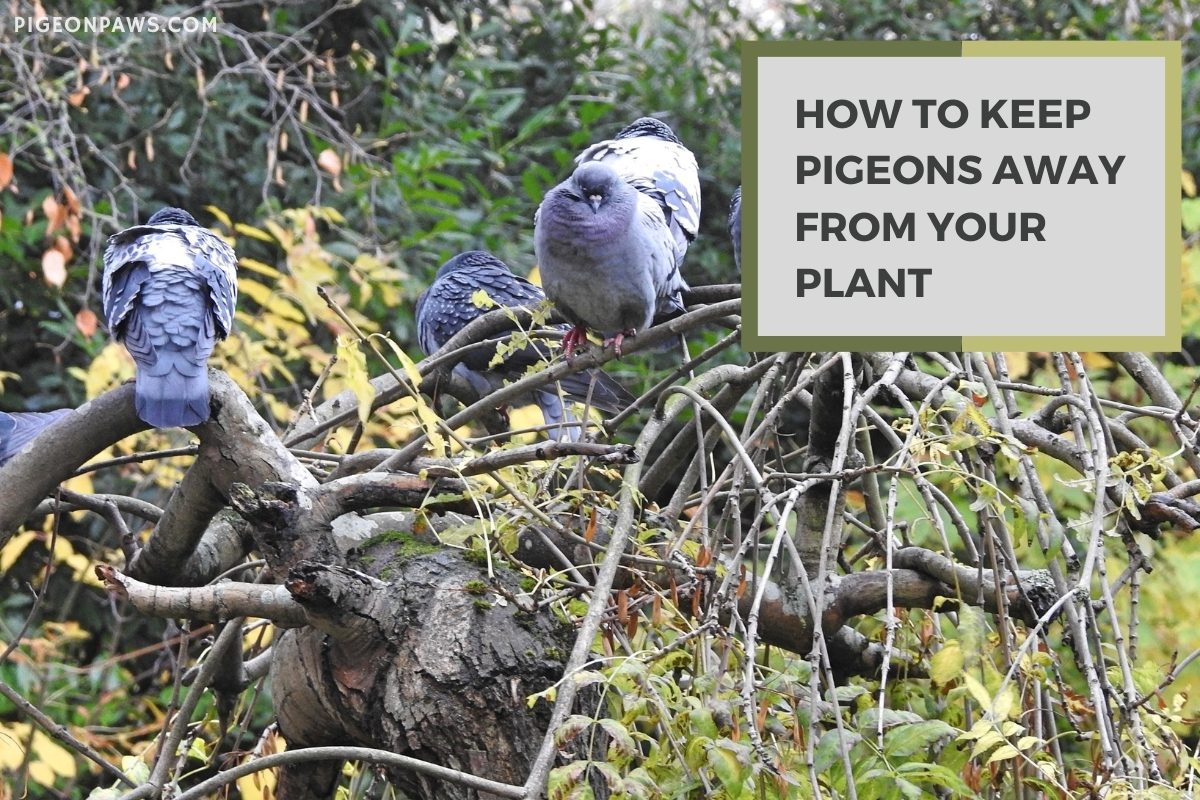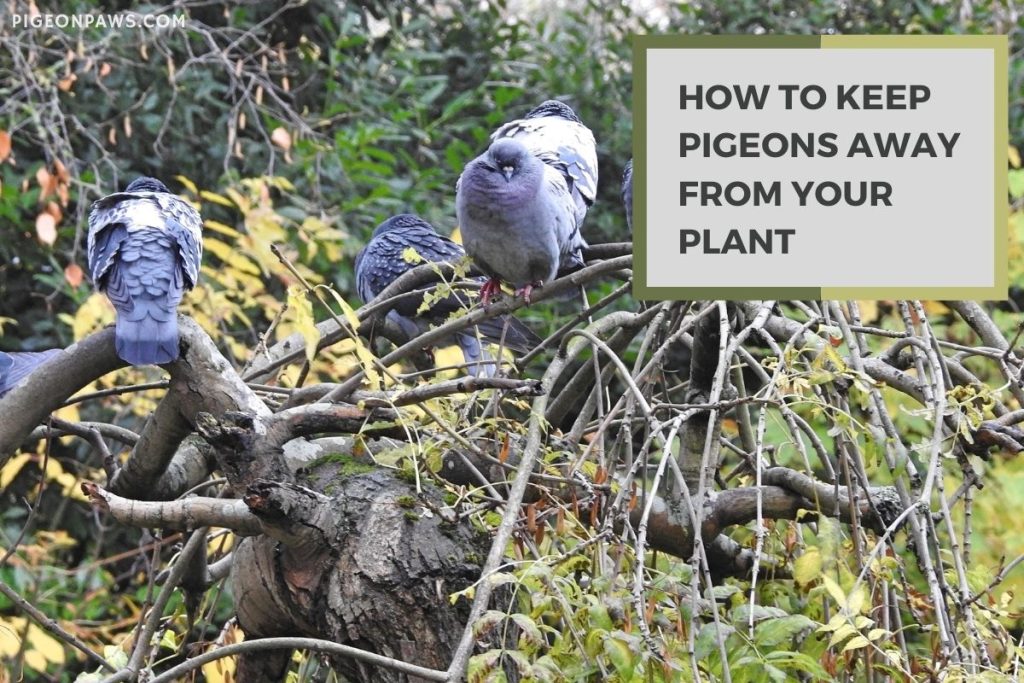How to Keep Pigeons Away From Your Plants? Proven Methods

Pigeons are frequently seen in urban and suburban regions, but when they start frequenting someone’s property, they might start to annoy people. They can eat the seeds and buds of flowers and vegetables in addition to leaving droppings on plants and patios. It’s time to act if one has had enough of the harm that these birds are causing.
Plants can be physically surrounded with chicken wire and netting to prevent pigeons from getting to them. This is an easy and affordable way to keep pigeons away. Additionally, displaying shiny objects may also be effective.
Read on to gain some mindblowing information as I go through some of the best strategies for discouraging pigeons from landing on your plants.

Dangers That Pigeons Posses Towards Your Plants
In metropolitan regions across the globe, observing pigeons perched on ledges, rooftops, and window sills has become a familiar sight. Although they may seem innocuous, these avian creatures can pose a significant threat to your flora. Pigeons are notorious for their penchant for devouring an assortment of plants, including leaves, flowers, and fruits, creating a cause for concern among homeowners and horticulturists alike.
Their proclivity for scratching and pecking at foliage and blooms can inflict severe damage to your garden or landscape. Their actions can result in physical harm to the plant, leading to a potentially adverse impact on its photosynthesis and food production abilities. Consequently, it is imperative to adopt measures to protect your plants from these avian intruders.
Pigeons may also infect your plants with parasites and illnesses by their droppings or touch with their feathers. This might result in the spread of fungi or the invasion of your garden by dangerous pests, both of which would further injure your plants.
In order to safeguard your plants, it is crucial to take action to stop pigeons from landing and feeding in your garden or on your property.
Innovative Ways to Keep Pigeons Away From Plants
Pigeons, as we all know, can be an annoyance when they perch on plants and harm them by nibbling at the leaves, breaking the stems, and distributing seeds. If you are producing fruit, vegetables, or beautiful plants in your yard, you must take comprehensive measures to keep pigeons from wrecking havoc. Here are some various strategies for deterring pigeons from plants.
Using Plants
There are several possibilities available if you’re seeking for a plant that can deter pigeons from visiting your yard. The most efficient plants are thyme, lavender, rosemary, and sage. Pigeons avoid locations where these plants are flourishing because of the strong odor that these plants emit.
These plants can also aid in keeping away other pests like rabbits and deer. Growing prickly plants like cactus or thorny roses is an additional choice. Pigeons will avoid locations with these plants because they dislike landing on sharp surfaces. If you have a significant pigeon problem, you might want to think about establishing a prickly shrub hedge.
Homemade Pigeon Repellent
If pigeons are nesting on your property, you might be seeking for a solution to the problem. You may produce your own homemade pigeon repellant in addition to the various commercial ones that are offered. One choice is to fill a spray bottle with an equal mixture of water and vinegar.
The places where pigeons are roosting can then be sprayed with this combination. The scent of vinegar will aid in preventing their reappearance. Another choice is to combine water, cayenne pepper, and garlic powder.
The vinegar solution can be sprayed in the same manner as this combination. If you’re searching for a longer-term solution, the pungent aromas of garlic and cayenne pepper will help deter pigeons.
Tin Foil
Yes, tin foil is frequently suggested as a potential deterrent for pigeons on your home. The foil’s crinkling sound is known to annoy them when disturbed, making it a powerful deterrent.
The foil should be positioned where pigeons are likely to perch or roost in order to maximize the effectiveness of this strategy. This may apply to locations where pigeons would be drawn, such as window ledges, balconies, rooftops, and other structures.
The foil should be frequently inspected for damage and changed as needed since if it is worn out, it will no longer be effective. It’s also crucial to remember that this procedure should be used in conjunction with other management measures because it might not always be enough to completely eradicate a pigeon issue.
Baking Soda
Pigeons and other bothersome birds can be deterred off your patio or window sill by using baking soda. The birds will feel uncomfortable if you sprinkle baking soda about their favorite perching spots, and they will probably flee the area.
It’s crucial to remember that this method only functions if you continue to use it consistently. To keep the baking soda working, you will need to apply it again frequently.
To maintain the area clear of bird droppings, which may create an unattractive and harmful environment, baking soda can also be used as a cleaning agent around the patio or window sill.
Weatherproof String
Use of waterproof string is one efficient and inexpensive pigeon deterrent strategy. I’ll demonstrate how to build a waterproof string in this article to deter pigeons from landing on your home.
Step 1: Gather Materials
You will need the following materials to make your weatherproof string:
- String or twine (nylon or polypropylene are good options)
- Scissors
- Waterproofing spray or coating (such as Thompson’s WaterSeal)
Step 2: Cut The String
The string should be measured and cut to the required length. The place where you want to keep pigeons away should have the string strung over it, either across a balcony or along a rooftop.
Step 3: Waterproof The String
Before installing the string, it’s important to ensure it’s waterproof. This will ensure that the string remains effective in keeping pigeons away, even in bad weather. Spray or coat the string with a waterproofing spray or coating, making sure to cover it completely. Allow the string to dry completely before continuing.
Step 4: Install The String
Tie the string securely across the area where you want to keep pigeons away. The string should be taut and about an inch above the surface, you wish to protect. Make sure the string is tied securely at both ends, so it doesn’t sag or come loose.
Step 5: Monitor And Maintain
Check the string regularly to make sure it remains taut and secure. If the string becomes loose or damaged, replace it as soon as possible. Additionally, reapply the waterproofing spray or coating every few months to maintain its effectiveness.
Keep Pigeons Away From Plants With These Tips
Can the Methods for Keeping Pigeons Away From Plants Also be Used to Get Rid of Pigeons from Trees?
Can the methods for keeping pigeons away from plants also be used to get rid of pigeons from trees? Many experts suggest that the same techniques can be effective in both cases. To successfully keep pigeons away from trees, experts recommend using deterrents like reflective devices, bird spikes, and ultrasonic devices. Additionally, trimming branches near rooftops and applying bird repellent gels can discourage pigeons from perching on trees. By employing these expert tips for removing pigeons from trees, you can maintain a pigeon-free environment for your plants and trees alike.
Conclusion
In the conclusion, we can say that although keeping pigeons away from your plants might be difficult, it is feasible with the correct techniques. There are a variety of techniques you may use to prevent pigeons from feeding in your yard, from employing physical barriers to utilizing organic deterrents and repellants.
Finding the right solution may depend on your location and the severity of the pigeon problem, but with some experimentation and persistence, you can protect your plants and enjoy a beautiful, pigeon-free garden.

